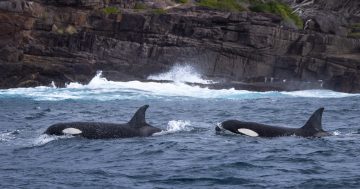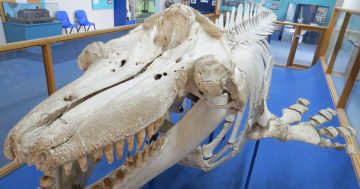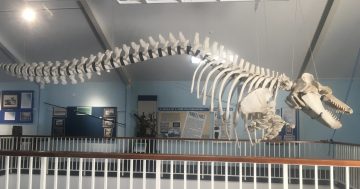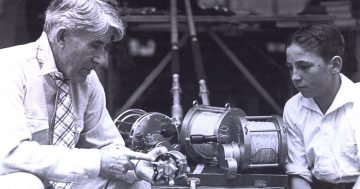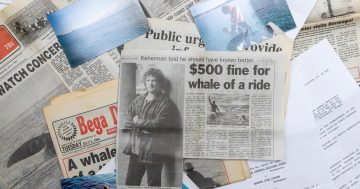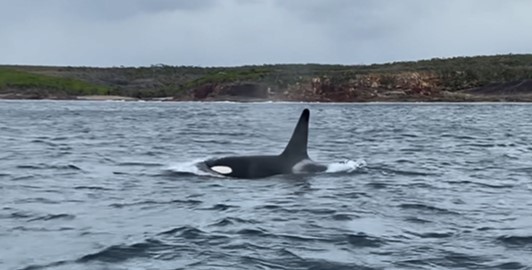
One of the killer whales spotted near Green Cape, south of Eden. Photo: Matthew Proctor.
Life-long diver and fisherman Matthew Proctor still remembers the first time he spotted killer whales on the Far South Coast.
“It was in 2006, I was on a patrol boat north of Montague Island and there was this mega pod, just dozens of killer whales,” he said.
“They were in a playful mood, bow-riding like dolphins do, carving through the sea.
“It was in crystal clear, cobalt blue water; it’s something I’ll never forget.”
It’s not hard for the NSW Fisheries officer to recall each encounter, as it’s only happened three times over his three decades working on the water.
“The second encounter was in 2014; I was standing on the beach at Haycock Point near Pambula,” he said.
“I was watching my son surf and I saw this small pod of killer whales out the back past the surf break.”
But it’s his latest sighting that has the community in a buzz.
On Thursday (21 April) the 53-year-old was heading out at pre-dawn on a solo fishing trip. Heading south, between South Head and Mowarry Point, he saw a wide area of disturbance in the water.
“There was a mega pod of common dolphins, seals and gannets going berserk,” he said.
“I knew under the water there would have been a massive bait ball situation.”
Matthew headed closer to Green Cape, thinking the fishing would be good at his favourite fishing spot, and happened to look up from his GPS.
“I saw the glimpse of a dorsal fin, which I now believe was the female killer whale, and knew this wasn’t a standard dolphin,” he said.
“Next minute the unmistakable dorsal of a male killer whale came out of the sea.”
Scrambling for his phone, Matthew managed to capture the encounter.
“I wanted to prove it wasn’t ‘one of those fishing stories’; when you’ve been fishing for so long people can tend to take your story with a grain of salt,” he said.
While the pair could have been in the area for the massive bait ball, eyeing off local seals or preparing for the humpback whale migration, Matthew has his own theory.
“I’m theorising they had eloped from a larger pod; I’ve put a bit of a romantic slant on it,” he laughed.
“They wanted to get away from the protocols of a larger pod and just enjoy some time together.”
Matthew’s encounter with the pair is one of five sightings reported from 21 April to 23 April.
Killer Whale Australia co-ordinator David Donnelly said the sightings were of the same pair, sometimes accompanied by a second male.
“The big adult male is known to us; he’s called ‘Bent Tip’ due to the bend in his dorsal fin,” he said.
“The other male is known just as ’60’, while the female is a bit of a mystery; she’s still unnamed at this point.
“We expect to see them [killer whales] this time of year in the area, but a lot of things need to line up for people to see them. The weather needs to be clear, the sea calm and of course they actually have to appear.
“I know with whale watch boats [in the area], there can be seven sightings one year and then none the next.”
The sighting also has those at the Eden Killer Whale Museum on their toes.
“It’s always exciting when they come; we’ve been urging people to keep an eye out,” museum secretary Jenny Drenkhahn said.
Killer whales aren’t a new phenomenon to the region, with records well back into the 1800s.
“They reportedly came to this area in early spring and used Twofold Bay as a trap,” Jenny said.
“They would push humpback whales into the bay and onto a reef, and then eat the lips and tongue, leaving the carcass.
“The local Indigenous people would then eat the meat, and they thought their elders had reincarnated as orcas, leaving them the food.”
When Europeans settled in the region and began whaling operations in the mid-1800s, a symbiotic relationship formed between the whales and whalers.
“Orcas are intelligent; they realised these whalemen were targeting whales, so the orcas would herd the humpbacks into the bay for the whalers to spear,” Jenny said.
“They would then eat the lips and tongue before the whalers would pull the carcass on board.
“It’s the only place in the world where this happened between orcas and man.”
While Matthew isn’t planning on forming such a relationship with the killer whales, he hopes he doesn’t have to wait too long before his next encounter.
“It seems to be happening every eight years; I don’t know what I can do to increase my chances,” he said.
“It was a great day; that’s why I keep coming back to the sea after 40 years.
“It will be a sad day when I can’t go out to sea because every day serves up something different; it keeps me coming back.”







